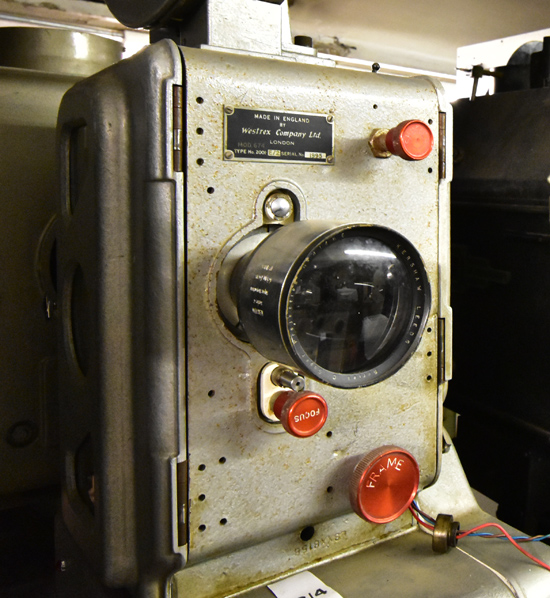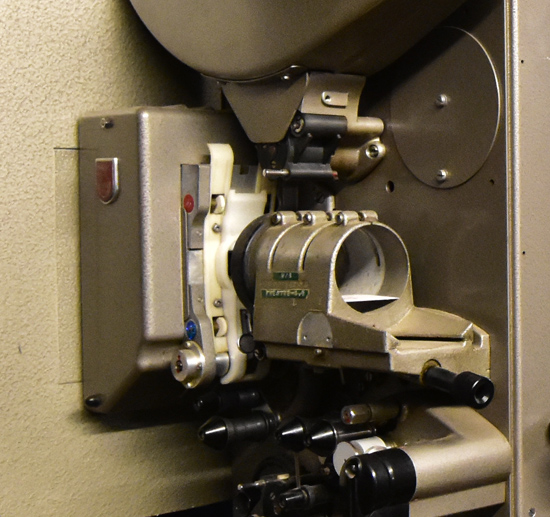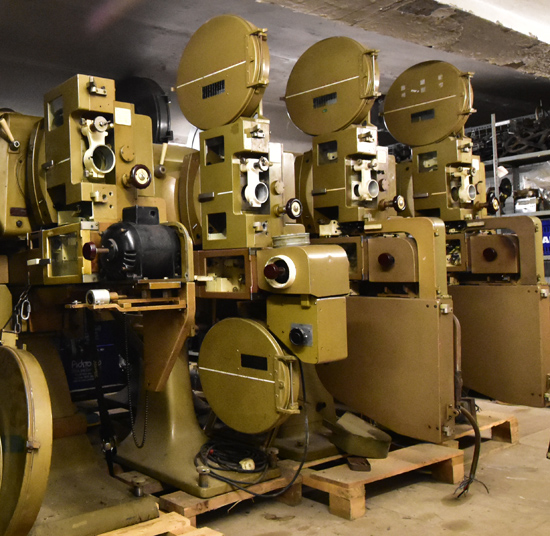The PPT Looking after cinemas heritage |
This article first appeared in |
| Written by: Mike Taylor. Pictures (2019) by Thomas Hauerslev | Issue 66 - November 2001 |
|
|
Further in 70mm reading: |
 Acquiring Equipment Acquiring EquipmentThe Trust saw no point in duplicating the fine work that was already being done by other groups concerned with the art and architecture of the cinema. Its mission was to fill in the gaps in these activities. That is why its efforts have been focussed on tracking down and restoring examples of the wide range of apparatus that, from the beginning of the 20th century, has brought the cinema to billions of people all over the world. Its first major acquisition was made within three months of the inaugural meeting. This was a complete set of equipment from Odeon's discontinued projectionists training school. More followed. Not only projectors but also ancillary items such as ticket-issuing machines from the London Pavilion, and items from other cinemas that were either putting up the shutters or updating their equipment. Meanwhile, various pieces of vintage machinery were being donated or loaned to the Trust by private collectors. These early prizes, the nucleus of today's massive collection, presented the PPT with a challenge it has been facing ever since. Cinema equipment is often very big and very heavy. Moving these items put a severe strain on the transport and lifting gear, not to mention the muscles of the members volunteering for this vital but unglamorous task. There was also the problem of finding 'free' storage and workshop space. It did not take long for the Trust's collection to outgrow the premises initially provided by the NFA at Berkhamsted in Hertfordshire. This necessitated the relocation of some equipment to a depot in the Midlands, previously used for the storage of nuclear warheads! The North London Cinema Society came to the rescue by providing storage and workshop space at the Film Centre in Muswell Hill. A significant advance was made at the beginning of 1984 when the Trust acquired premises at Duxford in Cambridgeshire in return for an undertaking to restore the former RAFCC Astra Cinema and provide film shows for Museum visitors. Duxford became the centre of much of the PPT's activities. The dilapidated cinema, with its wartime memories, was painstakingly renovated and the first public performance, using 50-year old projectors, was given in June 1987. For the next seven years, members of the PPT gave three shows a day on every Saturday and Sunday that the Museum was open to the public. This arrangement ceased in 1994 when the Museum decided not to provide a cinema facility for its visitors and the Trust's exhibition and storage space was much reduced. This meant that facilities had to be found elsewhere. Other stores were located in places such as Birkenhead, members' garages, front rooms, etc.! Restoration Work Much of the equipment tracked down by the PPT has been in need of restoration. Teams of enthusiasts with appropriate knowledge and skills have undertaken this. Restoration has been undertaken on the "workdays", regularly held at the Trust's regional centres. Individual members in their own homes or workshops have tackled other jobs. Restoration is an on-going process. There are always opportunities for members to play a part in it. They do not have to have engineering skills; the most valued contributions are enthusiasm and commitment! Educational Visits The Trust has arranged visits to significant sites in Britain and Europe. In some cases, this has given new members their first opportunity to see what actually happens inside a projection suite. Notable sites visited include the projection box at the Odeon Leicester Sq (London), the splendidly restored 1911 Electric Palace, Harwich, the National Museum of Photography, Film and Television, Bradford, the Belgian Film Archive, the Cinematheque Francais, Paris and the National Film Archive. |
|
 Keeping the Records Keeping the RecordsThe PPT preserves not only equipment but also the documentation relating to it: manufacturers' catalogues, operating and service manuals, etc. In 1986 all this material was transferred to the Archives' computer database to facilitate finding any item required by members and bona fide researchers. Publications The Trust's founders recognised that many of the individuals wishing to support its aims would be unable for geographical or other reasons to participate in the restoration work or organised visits. From the earliest days, all members received a newsletter reporting on meetings, notable acquisitions and many other activities. There were also specially written articles on all aspects of cinema history and technology. This is now a fully-fledged quarterly A4 magazine, free to members. From time to time, well-researched and illustrated information publications are produced on specific items connected With the PPT or the film production process. Public Displays Although 'preservation' is obviously the major item in the PPT's objectives, this has never been seen as an end in itself. Opportunities have been taken to put the fruits of restoration work on public exhibition. These activities started in 1981 with a display of vintage projectors and other items on the South Bank during the London Film Festival. More recently there have been displays at the Museum of the Moving Image and various regional film centres. Items from the PPT's collection have been provided on loan to museums and libraries, etc. 1984 saw the inauguration of what has become the PPT's permanent exhibition of cinema equipment, now known as The National Museum of Cinema Technology. This is at Bletchley Park, on the historic site (featured on television recently) where vital code-breaking work was accomplished during World War 2. Spreading Out From the start, the PPT saw itself as a national (and international) organisation. It was soon noticed that there was an imbalance in the location of its membership: 50% were in London and the Home Counties. In 1987, a basic re-assessment of PPT policy set a target: to establish branches throughout the UK, each with its own workshops and exhibition areas. That target, not yet fully attained, is reflected in the way the PPT now operates through its eight regional centres. Other conclusions were that the PPT should concentrate its activities within the professional field of motion picture technology; reduce the pressure on restoration facilities by giving priority to the reception of complete equipment in good working order; make equipment available for display or use at museums or other similar establishments and eventually to establish a headquarters with permanent staff. After twenty years some of the aims of the Trust's founders have yet to be fully realised, but they are now more firmly in place than ever before. The PPT is a dynamic organisation, building on its past and present resources. It offers unlimited opportunities for members of all ages to help preserve the technical achievements of the cinema in a manner befitting their cultural and social importance. For membership details, please send an addressed envelope to: The Projected Picture Trust, Dean Clough Mills, Halifax, West Yorkshire, HX3 5AX • Go to The Projected Pictures Trust. A Visit to the archive in Halifax, UK |
|
| Go: back
- top - back issues Updated 21-01-24 |

 In the 1970s more and more 'Picture Palaces' were being boarded-up, turned into
In the 1970s more and more 'Picture Palaces' were being boarded-up, turned into